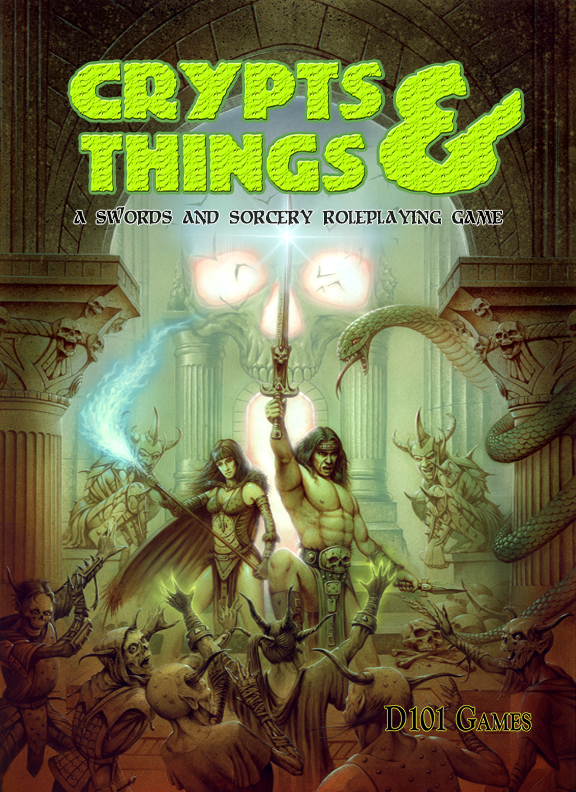As I mentioned in another post, one of the little projects that I'm working on is to design a Super Scientist class for DCC. My objective here is twofold. First, I want the class to play very differently from all the base DCC classes, to not merely be a Wizard re-skinned with gonzo science-fiction trappings. That sort of thing is lazy, and represents an excessive blurring of lines between literary magic and literary science.
My other objective may seem to be at odds with my first: I want the Super Scientist class to be "arcane" enough that it could easily be a stand-in for a more fantasy-oriented magician like an alchemist, or something even less defined. It is enough that one called "wizard" has access to weird powers and strange trinkets. We want to find a place between magic and science fiction, whereas the DCC Wizard is (mechanically) firmly rooted in fantasy.
There are a lot of settings and concepts that could accommodate the class, as I envision it. Consider the bizarre "wizards" of The Land of One Thousand Towers, in Patrick Wetmore's Anomalous Subsurface Environment. These power-mad tyrants each control fragments of a ancient technologies, technologies so advanced as to accomplish wondrous things. One has learned how to produce armies of obedient dog-men, while another is able to build powerful firearms that bind their wielders to his will and gets around in a giant flying metal head the shoots lasers from its eyes (of course).
There are examples closer to home, like the Venture Bros., Hannibal from the A-Team and even that 80's TV classic, MacGuyver. The point is that we can conceive of this class as something that straddles the divide between art and science. The Super Scientist is able to do extraordinary things, and the outcome of his endeavors is always affected by chance.
How, then, is the Super Scientist different from the standard DCC Wizard?
Wednesday, November 23, 2016
Wednesday, November 9, 2016
An RPG review: Crypts and Things Remastered
It's been a while since I've posted anything here; that's mainly because I'm still working on some new content (the DCC adventure I mentioned in an earlier post, as well as a completely novel DCC class...more on this another time). I've also absorbed even more tabletop RPG content. It's really getting out of hand.
Anyway, I've been running out of DCC materials that catch my attention, and I promised Stan that I wouldn't look too closely at Purple Sorcerer Games - this because he's thinking of running one of their DCC adventures! But there's still plenty of other stuff, and I can't really help myself.
Just the other day I was re-reading the excellent The Black Hack. I am intrigued by an OSR game that requires players to make all the dice rolls. Attacking? Roll to hit. Being attacked? Roll to avoid. TBH also introduces a unique mechanic to simplify and abstract bookkeeping for supplies: resource dice. Quantities of identical items are roughly measured by a die of a certain size (d20 for "a lot," d12 for "a bunch," and so-on until d4). When a character uses one of these items, roll the resource die - on a 1-2, drop the die size by one (e.g. a d12 becomes a d10). If the resource die was a d4, rolling 1-2 means that it's depleted.
Anyway, something I picked up recently was the very intriguing Crypts and Things Remastered. Written by Newt Newport and published by d101 Games, available on DriveThruRPG in hardcover, softcover and PDF forms. Like TBH, it's a (relatively) simple OSR game with a number of unique mechanics. The rules are tightly bound to the setting, which is a very specific swords-and-sorcery world that draws heavily from Appendix N literature.
So let's get into some specifics. What's to love about C&T?
Anyway, I've been running out of DCC materials that catch my attention, and I promised Stan that I wouldn't look too closely at Purple Sorcerer Games - this because he's thinking of running one of their DCC adventures! But there's still plenty of other stuff, and I can't really help myself.
Just the other day I was re-reading the excellent The Black Hack. I am intrigued by an OSR game that requires players to make all the dice rolls. Attacking? Roll to hit. Being attacked? Roll to avoid. TBH also introduces a unique mechanic to simplify and abstract bookkeeping for supplies: resource dice. Quantities of identical items are roughly measured by a die of a certain size (d20 for "a lot," d12 for "a bunch," and so-on until d4). When a character uses one of these items, roll the resource die - on a 1-2, drop the die size by one (e.g. a d12 becomes a d10). If the resource die was a d4, rolling 1-2 means that it's depleted.
Anyway, something I picked up recently was the very intriguing Crypts and Things Remastered. Written by Newt Newport and published by d101 Games, available on DriveThruRPG in hardcover, softcover and PDF forms. Like TBH, it's a (relatively) simple OSR game with a number of unique mechanics. The rules are tightly bound to the setting, which is a very specific swords-and-sorcery world that draws heavily from Appendix N literature.
 |
| See, I'm getting better at this! |
So let's get into some specifics. What's to love about C&T?
Subscribe to:
Comments (Atom)